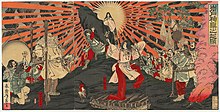Amaterasu
Amaterasu ( Japanese 天 照 ), with full name Amaterasu-ō-mi-kami ( 天 照 大 御 神 "Great, illustrious goddess shining in the sky", other names see below ), is the most important Kami (deity) of Shintō . She personifies the sun and light and is considered the founder of the Japanese imperial family .
According to the Kojiki , the oldest historical and mythological chronicle of Japan, Amaterasu was born through the left eye of the god Izanagi when he was cleansing himself of the defilements that he had incurred in the land of the dead in a river on today's island of Kyūshū . Together with her brother Susanoo no Mikoto , Amaterasu is chosen to take over the rule of heaven ( Takamanohara ) from her father Izanagi.
Amaterasu and Susanoo
However, Susanoo behaves like a naughty child and commits a variety of bad deeds and taboo violations. His worst offense: he throws a dead horse into the sacred weaving hall, where Amaterasu is currently working on the loom, and kills one of her servants. Amaterasu is so dismayed that she locks herself in a cave. As a result, the world is shrouded in darkness. The remaining gods try to lure her out of the cave again and for this purpose have the goddess Ama no Uzume perform a rather obscene and strange dance in front of the cave. Curious about the laughing and roaring that followed, Amaterasu pushes the stone that closes the cave to the side and sees her own reflection, because the other gods have also provided a mirror ( Yata no kagami ).
The sources report different things about the further course of events: One version tells that the mirror begins to shine through the beauty of Amaterasu and thus the world becomes bright again. Another reports that the sun goddess does not immediately recognize her reflection and wants to fight it. To do this, she has to get out of the cave and when she does that, the other gods block her way back.
Susanoo however is banished to earth, where he founds an earthly ruling family.
Ancestor of the Tenno family
After Susanoo's descendants have taken over the rulership on earth, Amaterasu sends her grandson Ninigi down from heaven to see if everything is going well. The transfer of power does not take place without threats, but ultimately without bloodshed. A connection between a descendant of Ninigi and a daughter of the Dragon King finally resulted in the first human ruler and thus ancestor of the Japanese imperial family. It is Jimmu , the mythological first Tennō of Japan, a great-grandson of Ninigi. As a result, all Japanese emperors trace their origin - and their authority - back to Amaterasu. The Ise shrine , the main shrine of this deity, is located in Ise , a little away from the former capital Kyoto . Amaterasu's emblem that is kept in this shrine is a mirror. The shrine itself is demolished and rebuilt every twenty years.
gender
The fact that the sun deity is considered a female deity in Japan is an exceptional case in comparative mythology. Various causes are asserted for this. Among other things, it is speculated that Amaterasu was originally thought of as male. When the Japanese gods and myths of origin were collected in the books Kojiki ( 712 ) and Nihonshoki ( 720 ), Empress Jitō was in power. Some researchers suspect that Amaterasu was therefore portrayed as a female deity to underline the empress's claim to rule. Other researchers point to other female sun deities, including Sunna in Germanic mythology .
Names
Like many other kami, Amaterasu has a number of different names depending on the context and aspect:
- Amatera-shimasu-sume-ō-mi-kami
- Amaterasu-ō-hiru-me-no-mikoto
- Amaterasu-sume-ō-mi-kami
- Amateru-mitama-no-mikoto
- Dainichi-nyōrai (also the name for the Adibuddha Vairocana, the sun-like. This is an identification often made within the Shinbutsu-Shūgō )
- Hiko-ho-akari-no-mikoto
- Ō-hiru-me-muchi-no-mikoto
- Ō-hiru-me-no-muchi
- Shinmei (also a common name for kami in general)
- Tenshō-daijin
- Tenshō-kō-daijin
- Tsuki-sakaki-izu-no-mitama
literature
- Jean Herbert: Shintô. At The Fountain-Head of Japan . George Allen & Unwin Ltd, 1967.
- Nelly Naumann : The Myths of Ancient Japan . Munich: Beck Verlag, 1996
- 筑紫 申 真 『ア マ テ ラ ス の 誕生』 角 川 書店 、 1962 年。 後 、 講 談 社 学術 文庫 、 2002 年ISBN 4-06-159545-8
Web links
- Mori Mizue: "Amaterasu" . In: Encyclopedia of Shinto. Kokugaku-in , March 15, 2006 (English)
- Bernhard Scheid: Introduction: Myths, Legends and Beliefs . In: Religion-in-Japan: A Web Handbook. University of Vienna, since 2001, as of March 23, 2017
- Sylvia Seelert: Amaterasu and Susano . The Mythentor, April 29, 2014
